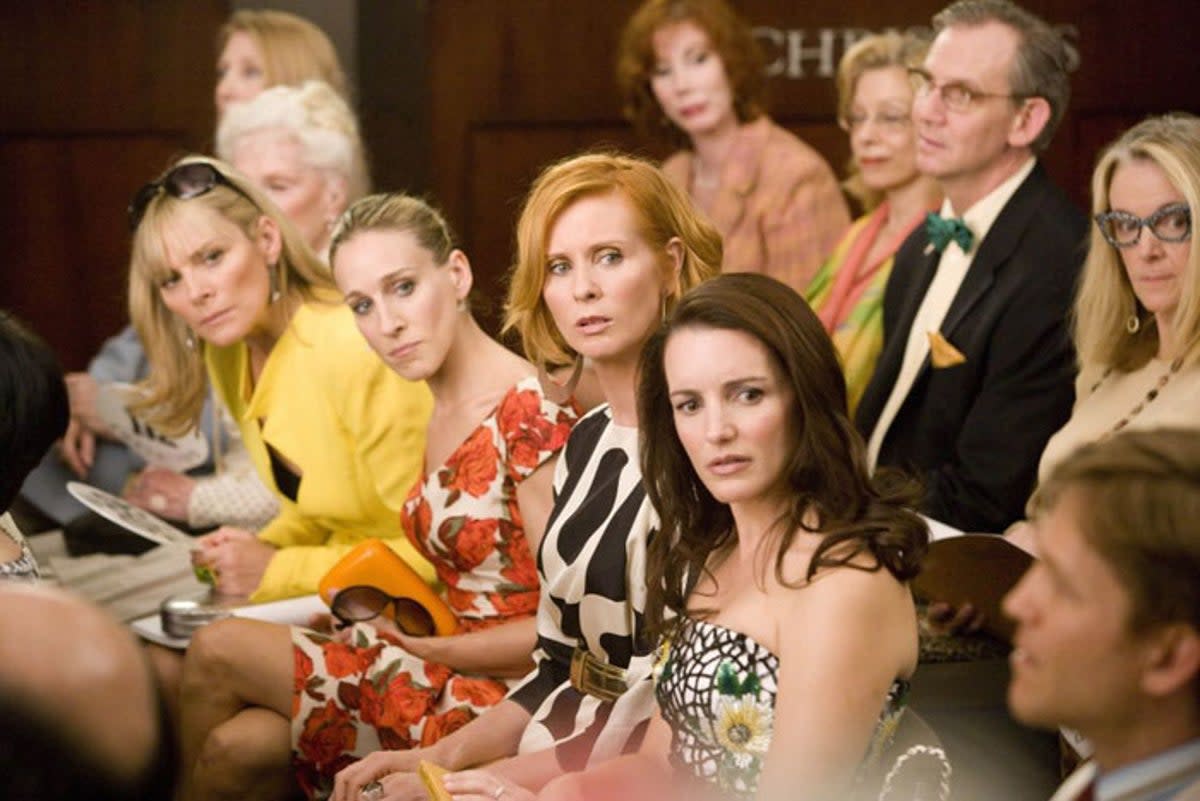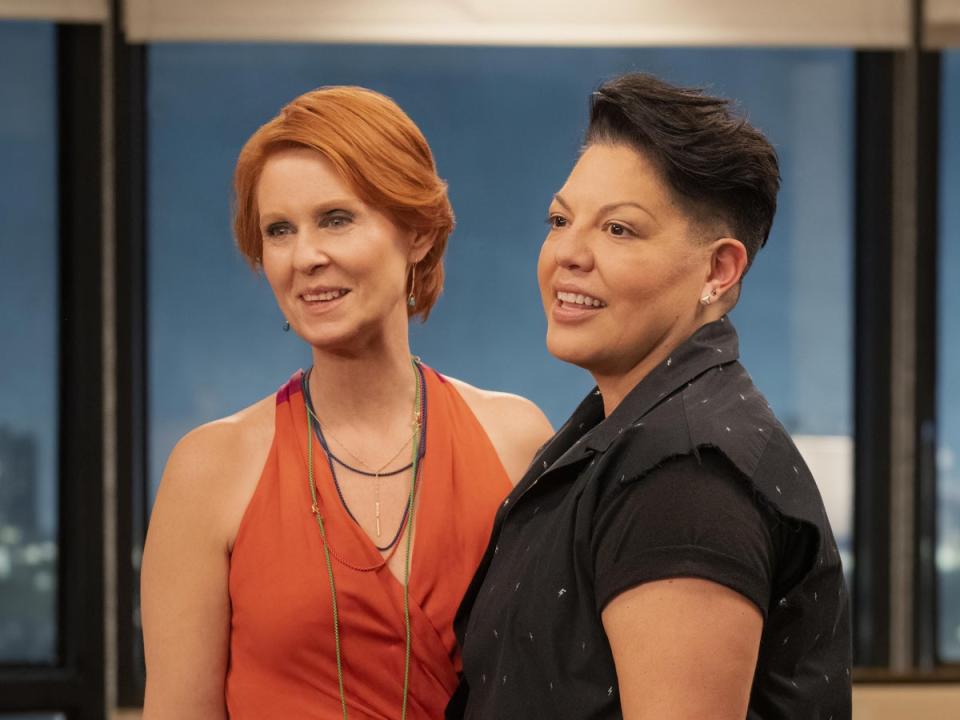What will Gen Z make of Sex and the City’s problematic elements?

It’s been a while since I saw “SATC” – aka Sex and the City – trending on social media. But the news that all episodes of the era-defining HBO series are streaming on Netflix in the US this month has put Carrie, Miranda, Charlotte and Samantha firmly back in the media spotlight.
“How exciting that a young person gets to discover Sex and the City for the first time,” tweeted one fan. “The glamorous journey they are about to embark on that many of us once took. And I mean look at me now (insane, completely out of touch, blinded by the idea of love, great coats).”
That said, my Twitter feed wasn’t exactly full of millennial women brimming over with nostalgia for our version of the Fab Four, but rather former viewers shrewdly wondering how the next generation would respond to the show’s more, shall we say, problematic elements. I couldn’t help but wonder – what will Gen Z make of our beloved New York quartet?
Of course, like anything made more than 25 years ago (SATC first aired in 1998, making me feel older than time itself), many of the prevailing sentiments don’t quite sit right in today’s culture. The overarching idea that being sexually liberated equals sleeping with pretty much every person you go on a date with, for one. But then there are the specific instances that feel more tangibly uncomfortable upon rewatching.
There’s the episode where Samantha deals with “inverse racism” when dating a Black man. The time Carrie goes out with a bisexual guy and insinuates it’s not a real sexual orientation. The one where the women clumsily grapple with the class divide while getting pedicures. The musician Carrie breaks up with because he has ADHD. The tone-deaf storyline where Samantha has an altercation with her “friendly neighbourhood pre-op transsexual hookers. Half man, half woman, totally annoying.” Oof.
And then there are the occasions I’d all but forgotten about – Twitter was there to remind me – where Carrie uses a “blaccent”, or fake “ghetto” voice, during some of the (very few) encounters the all-white group has with ethnic minorities. It made me do the physical equivalent of the grimace-face emoji. Was this really considered OK at the time? Were we all just... fine with it?
If you were a white female in the Noughties, the answer is clearly yes. I was OK with absolutely everything those women did and stood for. I wanted not only to be them, but to clamber through the television screen and enter their technicolour Manhattan world of wealth and sophistication and thinness; of designer outfits, $500 shoes, cosmos, fabulous brunches and hot new bar openings.
And, most of all, a world of men. I was at university when I first discovered this glittering slice of New York living – I even owned the iconic pink “shoebox” collection comprising every season on DVD. While boys consumed my waking thoughts, my success rate with the opposite sex left a lot to be desired.
But Carrie and crew faced no such obstacles. In every episode, they’d be dating someone new. In every scene, they’d effortlessly bump into an eligible man: while sitting in the park, going to the gym, browsing for books, attending a Weight Watchers meeting, giving witness statements after a mugging... in fact, it seemed impossible to leave the house without securing a date with a handsome stranger, with whom they’d inevitably end up having sex.
Even off-puttingly smart and normal-looking Miranda – and I was clearly “a Miranda” at the time when every woman could be categorised as one of the show’s four main characters – got laid on an aspirationally regular basis. Take me to that world! I thought. Maybe, just maybe, if I could move to a city after I graduated, I too would miraculously lose 20lbs, have a wardrobe not entirely populated by Primark, and be picked up while casually buying tampons from Boots.
Of course, I was sold a lie. It’s a TV show, after all. I rented a room in a Lewisham houseshare, and quickly realised that jobs that consisted of writing one weekly column while being paid well enough to cover cocktails, Louboutins and dinner out six nights in seven were not just rare but completely fictional. (Just ask any journalist about Carrie’s infamous “$4 a word” for Vogue gig and watch them detonate with rageful envy.)
Yet I can’t bring myself to hold a real grudge. This was also the show that pioneered plenty of radical concepts we had never been exposed to on screen before. Women who were both financially and emotionally independent. Women who focused on building successful careers and took professional pride in what they did. Women empowered enough to have sex with whomever they liked, whenever they liked, without shame, judgement or regret – who felt desire the same way that men did and weren’t afraid to ask for what they wanted.
It might feel somewhat dated now – and I think we’ve all reached a consensus that Carrie Bradshaw is the literal worst – but at the time it felt bold and subversive, a breath of fresh air amid the sexist lads’ mags culture that still caricatured women as playthings defined only by their “hotness”.

Just as Friends has had something of a reckoning as the next generation discovered its more questionable traits woven in among the brilliance – fatphobia, transphobia, sexism – so SATC’s less PC moments can’t be glossed over. Both shows were made in a different time, in an era in which offensive stereotyping was often allowed to slip under the radar to facilitate a cheap gag. But just like Friends, SATC is so much more than its worst parts. It’s also funny and moving – Samantha’s cancer storyline alone makes it worth your time – and visually gorgeous, a love letter to fashion as much as it is to New York City.
For all that flippant comments are made about “snowflake” Gen Z-ers and “woke” culture, it’s ignorant to suggest that the next generation are unable to enjoy art in its own specific context – alongside rightly calling out the language and scenes that no longer feel fit for purpose.
And perhaps it’s better to enjoy the show for what it was. After all, attempts to revise its less palatable ideological quirks via the reboot And Just Like That generally fell flat, with critics panning diversity tick-boxes that felt more clunky and shoehorned-in than a genuine reflection of modern life.
As another SATC stan put it on Twitter: “It was on air from 1998 to 2004. It was different times. We know that. Just watch it, enjoy some of the laughs and fashions.”
And, just like that, I decided a full rewatch was in order.


